

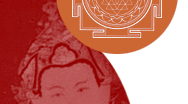 |
 |
|
|
~ Karmacharya Study | ~ Tantric
Healing Practices | ~ Rudi Statue | ~
The Chöd Tradition | ~ Project News and Articles
Karmacharya Study
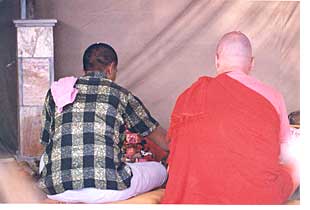 Nityananda Institute Nepal joined forces with the Center for Nepal and Asian Studies of Tribhuvan University on a research project to study the Karmacharyas of Bhaktapur, a caste of tantric priests. Dr. Tirtha Prasad Mishra, the Executive Director of CNAS, assembled a committee of researchers to conduct a seventeen month survey of the Karmacharyas, their practices and history. The research focused on the influence of Karmacharya tantric ritual on the society and culture of Bhaktapur. The study included a survey of extant source materials, including rare ritual texts, as well as field observation and interviews with practicing Karmacharyas.
Nityananda Institute Nepal joined forces with the Center for Nepal and Asian Studies of Tribhuvan University on a research project to study the Karmacharyas of Bhaktapur, a caste of tantric priests. Dr. Tirtha Prasad Mishra, the Executive Director of CNAS, assembled a committee of researchers to conduct a seventeen month survey of the Karmacharyas, their practices and history. The research focused on the influence of Karmacharya tantric ritual on the society and culture of Bhaktapur. The study included a survey of extant source materials, including rare ritual texts, as well as field observation and interviews with practicing Karmacharyas.
The ancient city of Bhaktapur, located eight miles east of Kathmandu, holds great importance in Nepali history. Home to the Newars, the most culturally significant of Nepal’s ethnic groups , Bhaktapur is the source of many of Nepal’s most important religious traditions. For centuries, Bhaktapur served as the Nepalese capital and the seat of the royal palace. Under the rule of the Malla kings from the 12th to the 17th century, Bhaktapur and the Newars developed a flourishing social, political and cultural system.
To ensure the protection and prosperity of the kingdom, the kings of Bhaktapur employed the Karmacharyas to perform elaborate devotional rituals to the local deities. The kings held the Karmacharyas in high esteem for their power and knowledge of goddess-based rituals. Their practices and ritual tradition had a great impact on the social, cultural and political development of Nepal. However, with the fall of the Malla dynasty in the 18th century, the Karmacharyas lost their position in the royal court and their status in society.Today, their role in history is largely forgotten.
The Karmacharyas who remain in Bhaktapur today provide the only living link to the ancient rituals of the Newar. This project provided a means to help preserve this significant tradition and contribute to a deeper understanding of Newari culture.
The research committee consisted of specialists in the field of Asian studies, including Professor Mishra, Swami Chetanananda, Director of Nityananda Institute Nepal and the CNAS Director of Socio-Religious Traditions of Nepal; Professor Alexis Sanderson of Oxford University, Professor T.B. Shrestha of CNAS, and Doctor Purushottam Lochan Shrestha, a historian specializing in Bhaktapur and Newari culture. The committee worked with a prominent Karmacharya, who acted as the liaison between the committee and the Karmacharyas.
The project began in September 2001 with a survey of source materials, including books, articles, inscriptions, chronicles and manuscripts in related topics, as well as relevant unpublished works from the National Archives and numerous other libraries. The final report was issued in September 2003.
Tantric
Healing Practices
In the tantric tradition, practitioners have generally had two goals:
to achieve the state of liberation or moksha, and to acquire power that
could be used for the benefit of others. That power often comes in the
form of siddhis, manifesting in unusual and extraordinary ways. One type
of siddhi that can emerge is the power of healing.
Several strains of tantric healing are practiced in Nepal. Healing practices
have developed among Buddhists, Hindus, and Bönpo groups. There is
also an indigenous shamanistic tradition practiced mostly by villagers
in the eastern and western hills, but its techniques are different from
tantrism.
Tantrism provides a technology for using creative energy or vital force
to effect healing. Healing power, however, does not manifest without careful
cultivation. Tantric healers have generally engaged in extensive sadhana,
which may include a period of ascetic practice. They may perform their
main healing practices in public, but there are also practices done privately,
the details of which are shared only between guru and student. The principal
tools employed in tantric healing in Nepal include mantra, the breath,
pujas (rituals), amulets, and various healing substances, such as blessed
water, rice, incense, ash, and herbal medicine.
Nepal is unusual in its widespread acceptance of tantric healing. For
most Nepalis, access to Western style medical treatment is simply not
possible, and for thousands of years the predominant form of healing has
been spiritual. For westerners, tantric healing methods can be effective
where other forms of treatment are not. Authentic practitioners, however,
are becoming increasingly rare. Swami Chetanananda is seeking to find
such practitioners and do what he can to help preserve these traditions.
One prominent tantric practitioner in Kathamandu is Lama
Tsering Wangdu Rinpoche, whose is known for his ability as a healer.
He is a Tibetan Buddhist of the Nyingma school, and his practices come
from the Zhi-je, or pacification of suffering, tradition of Padampa Sangye.
He is a master of Chöd as well as other healing rituals. Swami Chetanananda
has studied with him for several years, absorbing the essence of his practices
and becoming a lineage holder in his tradition.
Among the other methods of tantric healing that exist in Nepal, there
is one believed to represent the last vestiges of the tradition of Kashmir
Shaivism. Swami Chetanananda is currently studying with accomplished practitioners
of this method and has dedicated himself to learning as much as he can
about their practices.
Rudi
Statue
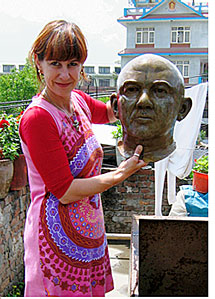 Nityananda
Institute Nepal has commissioned a life-sized statue of Swami
Rudrananda (Rudi) by Nityananda Institute student Karla Refojo and
Ravindra Jyapoo, a well-known Newari
sculptor/bronze caster in Kathmandu. When completed, the statue will be
installed in Nityananda Institute's Portland ashram.
Nityananda
Institute Nepal has commissioned a life-sized statue of Swami
Rudrananda (Rudi) by Nityananda Institute student Karla Refojo and
Ravindra Jyapoo, a well-known Newari
sculptor/bronze caster in Kathmandu. When completed, the statue will be
installed in Nityananda Institute's Portland ashram.
The statue will be cast using the traditional "lost wax" or cire perdu
method used in Nepal for centuries. The traditional process is complicated
and time-consuming, but allows the artisan to achieve very fine detail.
The Newari artisans of Kathmandu are among the best in the world at the
lost wax process. The tradition of metal casting in Nepal dates from the
Licchavi period (300-800 C.E.). The craft had become almost extinct by
the mid-twentieth century, but was revived with the arrival of Tibetan
refugees and the opening of Nepal to tourism, as a new market for the
work developed.
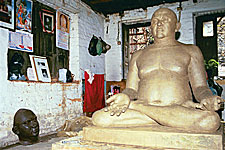 The
conditions in which Newaris work today and the techniques they use are
largely unchanged since the beginning of their tradition.They work in
poorly lit,small spaces with no ventilation, and yet turn out true masterpieces
displaying some of the most refined workmanship in the world.
The
conditions in which Newaris work today and the techniques they use are
largely unchanged since the beginning of their tradition.They work in
poorly lit,small spaces with no ventilation, and yet turn out true masterpieces
displaying some of the most refined workmanship in the world.
Work on the Rudi statue began in Ravindra Jyapoo’s small house at
the base of Swayambunath stupa in 2001. The statue began as a pile of
bricks which constituted the support at the base and the spine of the
statue. Clay, collected from the countryside outside Kathmandu, was brought
to the house and pounded to a smooth consistency, before being handed
over for the sculpture. Ravindra and Karla worked together on the statue
with few, simple tools, spraying the clay continuously with water to protect
it. The summer heat coming from the low tin roof and the wood fire smoke
from the casting ovens behind the house, would have quickly hardened and
baked the clay without it.
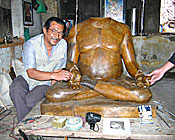 After
the sculpture was finished in clay, they needed to create a "die", a relief
copy of the statue made out of plaster. This die is also known as a "mother
mold" that enables the caster to make more than one copy of the statue.
Because this is a very large statue, in order to do this they first divided
the statue up into sections by inserting thin metal dividers into the
clay. These in turn acted as small walls to hold the plaster that was
then brushed onto the surface of the clay. After curing, the plaster sections
were carefully lifted off of the statue, cleaned, and checked for accuracy.
The clay statue was then destroyed, and the clay reconstituted to be used
again in future projects.
After
the sculpture was finished in clay, they needed to create a "die", a relief
copy of the statue made out of plaster. This die is also known as a "mother
mold" that enables the caster to make more than one copy of the statue.
Because this is a very large statue, in order to do this they first divided
the statue up into sections by inserting thin metal dividers into the
clay. These in turn acted as small walls to hold the plaster that was
then brushed onto the surface of the clay. After curing, the plaster sections
were carefully lifted off of the statue, cleaned, and checked for accuracy.
The clay statue was then destroyed, and the clay reconstituted to be used
again in future projects.
The next stage of the lost wax process is the preparation of a wax model,
exactly like the clay one. In order to do this, vegetable oil is brushed
onto the sections of the plaster dye as a resist, and then layers of melted
beeswax approximately one inch thick are brushed over that. The thickness
of the wax is important, since it determines the thickness the metal will
be afterwards. If it is too thin, it will lose strength. If it is too
thick, the cost of the metal is more and will result in a very heavy statue.
After the wax hardens, the wax is carefully pulled out of the plaster
molds, cleaned and checked for inconsistencies, and then joined all together
again into a single unit. When the statue is again in its complete manifestation,
this time in wax, it is thoroughly checked for accuracy in surface texture
and form. In order to cast such a big statue in bronze, the statue must
now be cut again into sections. For a statue of this size, six sections
are used: the head, the torso, the two arms, the legs and then the base.
The wax image is now coated in a slurry of fine yellow clay mixed with
cow dung and dried in the shade. Several layers of clay are applied, and
this process requires great care as it determines the quality of the surface
of the finished statue. The image is then coated with several thick layers
of coarse clay mixed with rice husks. Small openings are left in the clay.
When the mold is completely dry, it is heated in a special brick oven
and the wax flows out of the openings and is collected. The original wax
model, however, is lost.
The statue is then ready for casting. The Rudi statue will be cast using
the five-metal technique. Swami Chetanananda chose the five-metal technique
because it is the method traditionally used in Nepal and India to create
sacred images. This technique combines gold, silver, copper, zinc and
tin, each of which correlate vibrationally to planetary energies, similar
to the way gemstones are used in the Vedic system.
During casting, molten bronze is slowly poured into the mold. The mold
is allowed to cool before it is broken and the bronze statue removed.
Because the mold must be broken to release the statue, each statue made
using this process is one of a kind.
At this time the sections of the statue, now in metal form, are carefully
joined together to form a whole and the surface of the statue is cleaned
with sandpaper and files. The statue is then cold-forged—carefully pounded
with specially shaped dies to take out surface imperfections. The surface
is then polished. In the final stage of casting, the statue is carved
by an engraver with a hammer and special chisels to etch out the final
details. The statue is now ready for a patina, to add the depth and tone
of color desired. The Rudi statue will have a bronze, copper toned body
with an antique gold finish worn away over it, reproducing a 14th century
patina.
The Rudi statue was completed in the spring of 2006. Karla Refojo has
published an article about her experiences at asianart.com.
There's a short
article about the statue's arrival in Portland at the main Nityananda
Institute website.
The
Chöd Tradition
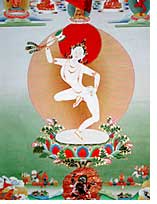 Chöd
is an ancient cremation ground practice of Indian Buddhist origin. It
is probably as old as Buddhism itself. According to scholars, Chöd has
never been a unified school of practice. Instead, it has various lineages
and traditions. One of the foremost practitioners of Chöd, Machig Labdroön
(1062—1153 C.E.), tailored the practice of Chöd to the particular
needs of her students, giving them different meditations that led to separate
lineages.
Chöd
is an ancient cremation ground practice of Indian Buddhist origin. It
is probably as old as Buddhism itself. According to scholars, Chöd has
never been a unified school of practice. Instead, it has various lineages
and traditions. One of the foremost practitioners of Chöd, Machig Labdroön
(1062—1153 C.E.), tailored the practice of Chöd to the particular
needs of her students, giving them different meditations that led to separate
lineages.
During a visit to Nepal in 1997, Swami Chetanananda encountered one of
the greatest living practitioners of Chöd, Lama
Tsering Wangdu Rinpoche. They both describe their first encounter
as a meeting of two currents. In the next year, Lama Wangdu shared his
practice with Swamiji and made him a lineage holder in the Jigme Lingpa
Chöd tradition.
The Chöd ritual is traditionally performed after dark in cremation grounds
or disturbed places. In the course of the practice, practitioners visualize
making an offering of their own bodies, which are cut up, transformed
into nectar, and distributed to various classes of guests who are called
to participate. The guests include spirits and negative energies that
cause harm and disease. After consuming the feast prepared for them, these
spirits are satisfied and subdued.
Chöd brings benefit to the total environment, including the practitioner.
The ritual involves a total sacrifice of everything identified as ourselves,
but it in no way diminishes us—it only makes us bigger. This understanding
is essential to authentic spiritual practice. As Swami Chetanananda says,
"Chöd is the ancient underpinning of all ritual practices."
Chöd has become a part of the programs offered at Nityananda Institute.
Hundreds of Institute students have received initiation in Chöd practice
from Lama Wangdu. Many of them have been practicing for several years.
Most of the students visiting Nepal have had the opportunity to see Lama
Wangdu practice Chöd at one of the main cremation sites or Vajrayogini
temples in the Kathmandu Valley.
This spring Nityananda Institute received a $5,000 grant to produce a
documentary about the art and iconography of Chöd. The project is called
"Art of the Chöd" and will focus on the imagery and ritual implements
used in the practice, using both old and modern examples. The film will
explain and de-mystify the powerful symbolism of Chöd for those unacquainted
with the practice. It will be the first documentary ever produced by the
Institute.
The idea for the film arose because the imagery associated with Chöd is
graphic and the deities invoked can appear menacing to the uninitiated,
who are not aware of the purpose of the practice. By explaining the purpose
of the ritual, the documentary will promote understanding of these images
and the nature of the practice among a wider audience.
The documentary will be produced in DVD format and will feature footage
of Lama Wangdu performing the practice, passages from the text practiced
at the Institute and Lama Wangdu’s and Swamiji’s commentary,
and paintings, sculpture and ritual implements from public and private
collections, including collections of students at Nityananda Institute.
.
This project is the first step toward another, longer film the Institute
would like to produce—a documentary about Lama Wangdu’s life
and practice.